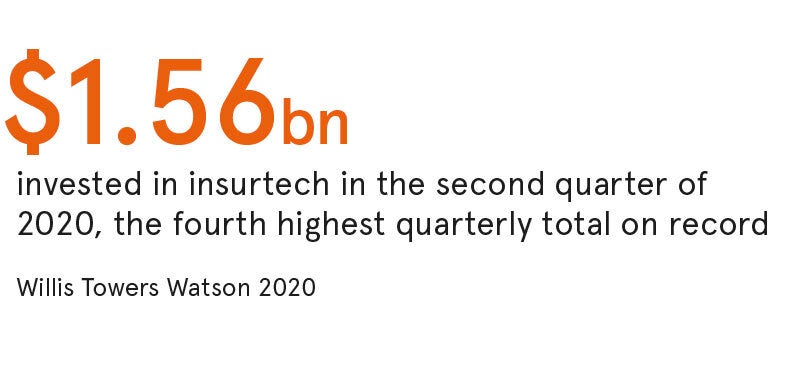
As the insurtech market continues to grow and primary insurers gain greater insights into their customers, reinsurance companies are scrambling to keep up. Not only are they having to contend with stricter data privacy rules, digital tools are also helping primary insurers learn more about their customers than ever before, giving them a potential pricing advantage when evaluating risk and selling those customers insurance cover.
“Historically reinsurers were seen as having really good data because they would get it from all the insurers, so they would have a slightly broader view. But there is a concern now that they have less data in comparative terms to insurers in part because the way you can use data is much more restrictive,” says Lee Bacon, insurance and reinsurance partner at Clyde & Co. “How you get down to that granular level is a challenge. So there is a sense there’s a gap that needs to be bridged somehow.”
This matters for reinsurers because, while they are still able to view data from multiple clients in aggregate, they are potentially missing out on the micro-details that would help them better price risk. One area where reinsurers are using technology to gather insights that can enable them to improve the risk-pricing process is with catastrophe risk, says Jobay Cooney, senior managing director at Aon Benfield.
“One of the technologies reinsurers are implementing is high-resolution aerial imagery, computer vision and machine-learning for property risk assessment,” he says. “For example, they can perform a qualitative review with that technology of every insurance client’s roof. So they get a portfolio of risk and then look at individual roof condition, which is an important element of catastrophe risk, enabling them to put a qualitative score on it and make the underwriting capacity and pricing decisions based on this new and often more accurate data.”
Catastrophe risk pricing
Allianz Re, in-house reinsurance arm of global insurer Allianz Group, is also using data to improve catastrophe risk pricing. It takes the data it gathers from its global insurance entities and then overlays that information on geographical maps to help identify concentration hotspots where insurers could potentially be overexposed to catastrophe risks, says Dr Sibylle Steimen, managing director at Allianz Re.
For any pricing you need data intake mechanisms and currently these mechanisms are still in the stone age
“In our entities there are huge efforts to make the pricing systems more accurate and detailed,” she says. “When it comes to floods, our aim is to really do it on an individual location basis because it is super important that you have the accurate location and price the risk accordingly because a couple of metres left or right can mean a big potential loss or not.”
Data quality is also an issue that many reinsurers have to grapple with given it often comes in a range of unstructured formats. Greg Boutin, chief executive of insurtech company Relay, says the ability to obtain cleaner data from clients will enable reinsurers to price risk better and faster.
“Once you get data in a format that’s machine friendly, then you have a much greater ability to apply your pricing algorithms and other things to it,” he says. “For any pricing you need data intake mechanisms and currently these mechanisms are still in the stone age.”
Improving client relationships
Technology can not only help reinsurers price risk more accurately, it also has the potential to build better relationships with their clients. Take Swiss Re. It has set up its own tech platform iptiQ, a white-label insurance provider that allows insurers to adopt a digital distribution model without having to invest in developing the technology themselves. By using iptiQ’s cloud-based applications and data-analytics tools, it makes buying insurance easier for end users. And it also gives Swiss Re the ability to partner with non-traditional providers such as banks and retailers.
“Traditionally, Swiss Re is a risk-pricing and a capital-risk provider, but now, through iptiQ’s platform and technology, we’ve also become a technology provider,” says Carl Christensen, chief executive of iptiQ, life and health, in Europe, Middle East and Africa. “If our partners like what we do and we can improve their insurance service and performance through technology, then clearly the relationship becomes stickier.”

Technology could also encourage reinsurers and insurance carriers to collaborate more effectively. One area that is ripe for collaboration, says Aon Benfield’s Cooney, is emerging risks around autonomous and semi-autonomous vehicles. “It’s really a greenfield in utilising data and technology to understand the risk and that could be very important,” he says.
But tech-based collaboration is not without challenges. “There is a common interest in having and sharing as much anonymised data as you can, but you need a system that everyone is using to get the most benefits from it,” says Bacon. “If you have one person using Betamax, another using VHS and another using Blu Ray, that doesn’t really work. The question is how does the market agree on common platforms and access requirements?”
To find out more, read Resilience in Financial Services

As the insurtech market continues to grow and primary insurers gain greater insights into their customers, reinsurance companies are scrambling to keep up. Not only are they having to contend with stricter data privacy rules, digital tools are also helping primary insurers learn more about their customers than ever before, giving them a potential pricing advantage when evaluating risk and selling those customers insurance cover.
“Historically reinsurers were seen as having really good data because they would get it from all the insurers, so they would have a slightly broader view. But there is a concern now that they have less data in comparative terms to insurers in part because the way you can use data is much more restrictive,” says Lee Bacon, insurance and reinsurance partner at Clyde & Co. “How you get down to that granular level is a challenge. So there is a sense there’s a gap that needs to be bridged somehow.”

